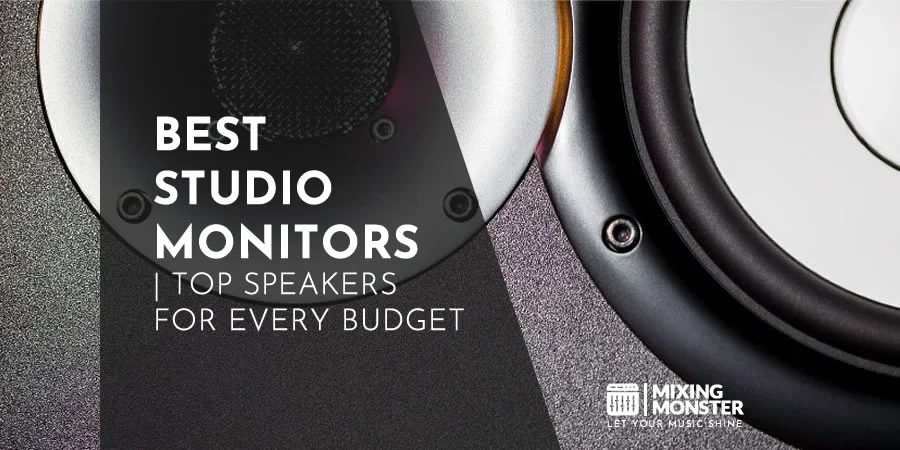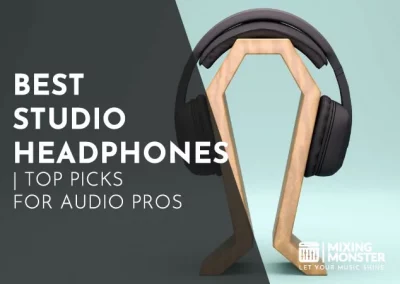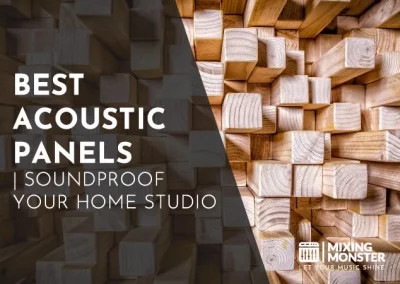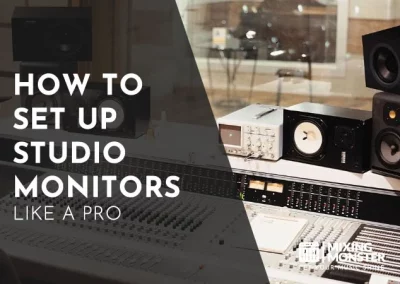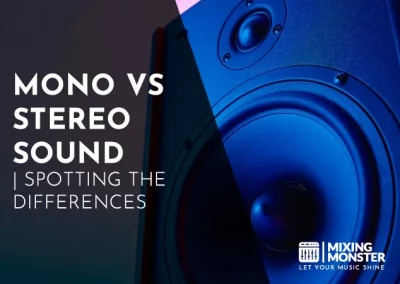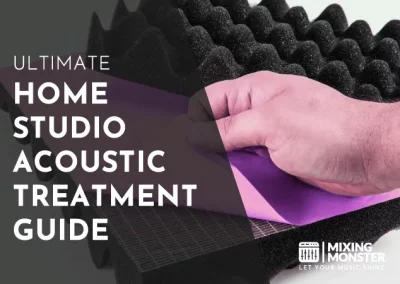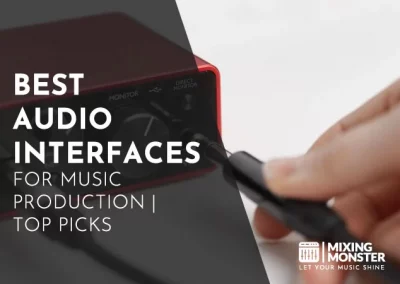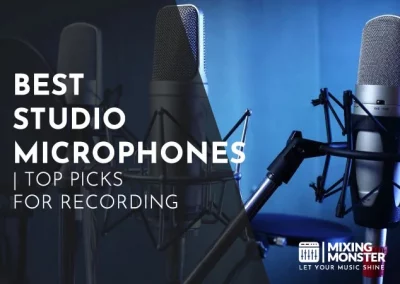Home > Blog > Studio Gear > Home Studio Gear
Disclosure: Some of the links below are affiliate links, meaning that at no additional cost to you, we will receive a commission if you click through and make a purchase. Read our full affiliate disclosure here.
Studio monitors are specialized loudspeakers critically important in audio production environments where precise sound reproduction is vital. Unlike consumer hi-fi speakers, which may enhance specific frequencies to flatter the sound, studio monitors are designed to provide a flat frequency response so producers and engineers can hear an accurate representation of the audio they are creating.
Studio monitors come in various shapes and sizes, catering to professional audio production needs. They may differ in driver size, power rating, and the type of enclosure, which can be either active or passive. The most accurate monitors offer an uncolored and neutral sound field, enabling critical listening and decision-making in mixing and mastering processes.
When selecting the best studio monitors for your needs, several key factors come into play. It is crucial to consider the size of the studio space, as too large monitors can overwhelm a small room and vice versa. Monitor placement and room acoustics also significantly influence performance, so choosing monitors with appropriate adjustment settings will help tailor the output to your environment.
We understand the importance of getting every detail right in audio production. Therefore, our commitment is to guide you through choosing studio monitors that will elevate your work, ensuring they sound impeccable on any system. With thorough research and rigorous testing, we’ve identified standout monitors that promise accuracy and reliability for any serious audio work.
KEYNOTES:
- In this article, you’ll find a comprehensive list of the best studio monitors on the market.
- Studio monitors are categorized into 3 sections:
Best Budget Studio Monitors
Best Midrange Studio Monitors
Best High-End Studio Monitors - Each section contains:
5 Studio Monitors
ordered by price (low > high)
Our Top Picks – Best Studio Monitors
Best Budget
KRK
Rokit 5 G4

Best Midrange
Adam Audio
T7V

Best High-End
Neumann
KH 120 II

Table Of Contents
1. What Are The Best Studio Monitors?
Best Budget Studio Monitors
Best Midrange Studio Monitors
Best High-End Studio Monitors
2. What Is A Studio Monitor?
3. Studio Monitor Buying Guide
4. Finding Your Perfect Studio Monitor: Key Takeaways
FAQ

1. What Are The Best Studio Monitors?
Finding the right studio monitors can elevate your audio production work for mixing, mastering, or just enjoying a highly accurate sound reproduction.
We meticulously tested various models to ascertain which ones stand out regarding clarity, frequency response, and overall fidelity. Our selection includes monitors that promise exceptional performance and value, ensuring you can decide to enhance your studio setup.
Here Are Our Picks For The Best Studio Monitors:
Best Budget Studio Monitors
1. Mackie CR3-X
Best For Home Studios On A Budget
2. Presonus Eris E5
Best For Home Studio Beginners
Best Midrange Studio Monitors
6. Adam Audio T7V
Best Midrange Studio Monitor Choice
8. Yamaha HS7
Best For Home Studio Mixing
9. Kali Audio LP-6 V2
Best For Spatial Audio Perception
10. IK Multimedia iLoud MTM
Best Self-Calibrating Studio Monitor
Best High-End Studio Monitors
11. Adam Audio AV4
Best For Professional Audio Recording
13. Dynaudio LYD7
Best Integrated DSP In A Studio Monitor
14. Genelec 8030 CP
Best For Serious Audio Enthusiasts

Best Budget Studio Monitors
#1 Mackie CR3-X
Best For Home Studios On A Budget

Overview:
We found the Mackie CR3-X monitors a solid choice for enhancing audio playback in our home studio setup.
Pros:
- The compact size is ideal for small studios
- Front-facing headphone jack offers convenience
- Includes all necessary cables for easy setup
Cons:
- It may produce a slight hiss at high volumes
- Bass response is limited due to size
- No Bluetooth connectivity for wireless streaming
Unique Selling Point:
The Mackie CR3-X stands out with its professional studio-quality sound in a compact package perfect for tight spaces.
Key Benefits:
- 50 watts of clean power delivers articulate stereo sound, serving clear high and mid frequencies.
- Versatile input options, including 1/4″, 1/8″, and RCA, cater to various audio sources and setups.
- The auto-defeat speaker output when headphones are plugged in provides a seamless transition from speakers to private listening.
Pricing:
| Average Price | ~ $79 (Pair) |
Review:
We’ve spent quality time with the Mackie CR3-X monitors and are impressed with their performance in our creative projects. Whether mixing a new track or enjoying some favorite tunes, these monitors provide a clear, precise sound that rivals more expensive options. Their size makes them incredibly easy to place in any room without compromising sound clarity.
Using these monitors with our laptop and audio interface was a breeze. The flexible inputs allowed us to connect multiple devices, and the inclusive cables meant we didn’t have to purchase anything extra. This was music to our ears, literally.
We noted that the lower frequencies aren’t as pronounced, which is expected given their size; however, tweaking our audio source’s equalizer settings can help compensate for this. They’re pretty loud for their size, which impressed us during our testing.
The precise mid and high frequencies stand out, making the listening experience enjoyable.
Still, it’s worth mentioning that there is a slight hiss at higher volumes, but it’s hardly noticeable unless you’re in a tranquil environment. It’s a minor flaw in what are otherwise great value monitors.
In conclusion, after thoroughly testing the Mackie CR3-X, they make a great addition to any home studio or multimedia setup, especially given their price point. They’re handy for various applications, from casual listening to more demanding audio work.
#2 Presonus Eris E5
Best For Home Studio Beginners

Overview:
After spending some time mixing with the PreSonus Eris E5 monitors, we have found them to deliver reliable and accurate sound for various audio projects.
Pros:
- Crisp, clear highs and solid low-end without distortion
- Functional acoustic tuning controls to adapt to different environments
- Includes valuable production software, enhancing the overall value
Cons:
- Bass may need a subwoofer for some users.
- Midrange clarity could be improved.
- Limited volume headroom for larger studio spaces
Unique Selling Point:
The unique selling point of the PreSonus Eris E5 is its high-quality sound reproduction combined with professional acoustic adjustment controls, which often come at a higher price point in the market.
Key Benefits:
- The woven composite woofers offer a substantial low-end response, ideal for detailed mixing sessions.
- Precise acoustic tuning allows for environment-specific adjustments, which ensures mixes translate well across various listening scenarios.
- Including valuable music production software with the monitors adds significant value, especially for those setting up a home studio.
Pricing:
| Average Price | ~ $115 |
Review:
We’ve put the PreSonus Eris E5 through its paces in our home studio setup, and they’ve met our critical listening needs. The construction is robust, and each component feels crafted to last. During our testing, the clarity of the highs impressed us, thanks to the silk-dome tweeter, which imparted a smoothness to the sound usually reserved for more expensive models.
The low end was surprisingly substantive for a monitor of this size. However, we did notice that the monitors needed an additional subwoofer to fill the room in larger spaces. This would be a minor issue for smaller studio environments or those who prefer a less bass-heavy mix.
The middle frequencies were decent, although there was room for more separation compared to other monitors in a similar range. The acoustic tuning controls allowed us to dial in the sweet spot, making them versatile across various musical genres.
One of the standout features for us was the inclusion of the Studio One Prime DAW and Studio Magic plug-in suite. For budding producers, this bundle is a treasure trove and greatly enhances the overall value of the Eris E5.
The PreSonus Eris E5 monitors represent solid value for audio enthusiasts and those setting up their first home studio. While they might lack the power needed for larger spaces, within their intended nearfield context, they shine with crisp highs and commendable versatility.
#3 Pioneer Dj DM-40D
Best For Small Home Studios And Compact Setups

Overview:
We recommend the Pioneer DJ DM-40D for those needing a versatile monitor with a compact footprint.
Pros:
- Versatile two-way sound mode for DJing and music production
- Connects easily with various DJ and production equipment
- Innovative design for tight, punchy bass and clear sound at high volumes
Cons:
- There is no power indicator to confirm the active status
- Some users report technical issues after short-term use
- Potential uneven audio output when using certain connections
Unique Selling Point:
The Pioneer DJ DM-40D shines with its two-way sound mode. This feature makes it uniquely accommodating to both live DJ performances and meticulous music production. Toggling between modes is a game-changer for our multitasking audio needs.
Key Benefits:
- The dual sound mode offers flexibility, suiting our every musical endeavor, from pulsing beats to subtle sound edits.
- The ease of connecting different gear makes it the central hub for our audio setup, reducing the clutter of additional equipment.
- The design includes a front-loaded headphone jack and level knob, which makes volume adjustments and private listening hassle-free while in the creative flow.
Pricing:
| Average Price | ~ $149 (Pair) |
Review:
When we fired up the Pioneer DJ DM-40D, the balance between clarity and punchiness, these monitors delivered was exceptional for their size. The 4-inch woofer held its ground, pumping out grooves with vigor and precision. During some creative sessions, we pushed the volume and found no distortion, just pure, uncolored sound filling our space.
One thing that stood out was the front panel’s user-friendly layout. Adjusting the volume and plugging in headphones didn’t require us to fumble around the back; everything was within arm’s reach. Some speakers overlook such small details, but we appreciate this thoughtful touch.
On the downside, the lack of a power indicator caused a stir when we first set them up. It could have been clearer if they were on, which added unnecessarily to our troubleshooting steps. And while we didn’t encounter connection issues ourselves, some users have had grievances, which could be a caveat to consider.
Overall, the Pioneer DJ DM-40D left us impressed. With its robust build, versatile inputs, and dual sound modes, we found it a solid anchor in our home studio setup. Despite some potential quirks, these monitors could be just the compact powerhouse you’ve been searching for.
#4 Yamaha HS5
Best Flat Response Studio Monitor In This Price Range

Overview:
The Yamaha HS5 Studio Monitor is a compact reference speaker designed to deliver precise sound reproduction. A 5-inch cone woofer and a 1-inch dome tweeter offer a flat response ideal for mixing and mastering tasks. The HS5’s bi-amplified design ensures that each driver is powered independently for precise, accurate audio across all frequencies.
Pros:
- Flat and accurate frequency response for precise monitoring
- The bi-amplified design provides high performance with low distortion
- Room control and high trim response controls for sound optimization
- Compact size suitable for small studios or desktop setups
- Renowned Yamaha build quality and reliability
Cons:
- Bass response might be insufficient for some without a subwoofer
- Not the most powerful monitor in its class, it may require a paired subwoofer for full range
- Highs can be slightly pronounced at higher volumes
- Lacks built-in Bluetooth or wireless connectivity
- Some users may find the design too simplistic
Unique Selling Point:
The unique selling point of the Yamaha HS5 Studio Monitor is its ability to deliver an authentic sound with an exceptionally flat response. This makes the HS5 a trusted tool for audio professionals and enthusiasts who need to hear uncolored sound, ensuring mixes translate well to other listening environments.
Key Benefits:
- Accurate sound reproduction allows users to make informed mixing decisions.
- Independent driver amplification provides clarity and reduces distortion.
- Versatile controls enable adaptation to various room acoustics.
Pricing:
| Average Price | ~ $145 |
Review:
The Yamaha HS5 Studio Monitor stands out in the crowded market of studio monitors by offering an unparalleled flat frequency response, essential for accurate monitoring.
At the beginning of any mix, you need a reliable set of ears; the HS5 provides just that. Its 70W bi-amplified power drives the woofer and tweeter separately, reducing distortion and ensuring your hearing is as close to the original recording as possible.
The build quality is what you would expect from Yamaha: robust and designed to last. Whether you’re a budding home studio enthusiast or a seasoned audio professional, the HS5 can be central to your audio setup.
The monitor’s room control features allow you to adjust the output to the acoustics of your space, which is essential for those dealing with less-than-ideal mixing environments. The high trim response further tailors the sound to your preference, ensuring you can work long hours without ear fatigue.
However, the HS5, with its 5-inch woofer, may not provide the deep bass that some might be looking for. This can be a drawback for genres that rely heavily on sub-bass frequencies, but it can be easily remedied by adding a subwoofer, such as the Yamaha HS8S. Also, while the design is sleek and professional, some users prefer studio monitors that make more of a design statement.
Regarding connectivity, the HS5 is straightforward, focusing on the essentials with XLR and TRS phone inputs. While the lack of wireless features might be seen as a con, it ensures a pure and unadulterated signal path, often preferred in professional settings.
In conclusion, the Yamaha HS5 Studio Monitor is a workhorse that offers honest and accurate monitoring. It’s an excellent choice for those serious about their mix and wanting to hear the truth in their music. While it may not have the frills of Bluetooth connectivity or an eye-catching design, it excels at its core function – providing a reliable reference for your audio work.
At the end of the day, when the mix is done, and you play it back on different systems, the HS5’s trustworthy reproduction means there will be no surprises, and that’s precisely what you need from a studio monitor.
#5 KRK Rokit 5 G4
Best Entry-Level Studio Monitor Choice

Overview:
The KRK Rokit 5 G4 Studio Monitor is renowned among audio professionals and hobbyists. This next-generation studio monitor has been re-engineered from the ground up to include the best of KRK’s 30 years of innovation.
With state-of-the-art DSP-driven room tuning and a scientifically designed speaker enclosure, the Rokit 5 G4 delivers unmatched performance and accuracy for mixing, mastering, and playback.
Pros:
- Exceptional sound clarity and precision
- Built-in DSP-driven room tuning with 25 visual Graphic EQ settings
- High-quality low-frequency drivers for enhanced bass
- Optimized high-frequency waveguide for wide, detailed soundstage
- Durable construction with a sleek design
Cons:
- It may require additional acoustic room treatment for optimal performance
- Some users may prefer a more neutral sound signature
- DSP features may be complex for beginners
- It is not the most portable option due to size and weight
- Limited low-end response compared to larger monitors
Unique Selling Point:
The unique selling point of the KRK Rokit 5 G4 Studio Monitor is its advanced DSP-driven room tuning. This feature allows users to adjust the monitor settings to the specific acoustics of their workspace, ensuring the most accurate sound reproduction possible.
Key Benefits:
- The built-in Graphic EQ enables precise sound shaping to accommodate personal preferences or room acoustics.
- The high-quality drivers ensure clear, distortion-free audio across all frequencies.
- The scientifically designed enclosure minimizes unwanted resonance, providing a clean and focused listening experience.
Pricing:
| Average Price | ~ $139 |
Review:
The KRK Rokit 5 G4 Studio Monitor stands out as a top contender, offering professional-grade sound quality at a reasonable price. From the moment you power it up, the attention to detail in sound reproduction is evident, with crisp highs, clear mids, and tight bass response.
The build quality is robust, ensuring that the monitors sound good and can withstand the rigors of daily use. The integrated DSP makes it easy to adapt the monitors to any room, a feature especially useful for those working in less-than-ideal mixing environments.
While it may take some time to get used to the advanced features, the effort is well worth it, as it allows for a highly customized listening experience that can dramatically improve the quality of your mixes.
One of the most impressive aspects of the KRK Rokit 5 G4 is its versatility. Whether you’re recording, mixing, or simply enjoying music, these monitors provide a truthful representation of the sound, which is crucial for making accurate adjustments and decisions.
The low-end is punchy and tight without being overpowering, and the highs are crisp without being harsh. These monitors genuinely shine in the midrange, offering a level of detail often reserved for more expensive models.
However, it’s important to note that to unlock the potential of the Rokit 5 G4 truly, you’ll need to spend some time with the DSP room tuning. This process can be daunting for those new to studio monitors, but the manual provides clear instructions, resulting in a monitor perfectly adapted to your space.
In conclusion, the KRK Rokit 5 G4 Studio Monitor is an exceptional choice for anyone looking to upgrade their home studio or audio setup. Its sound quality, build, and advanced features make it a valuable tool for any audio professional or enthusiast. Whether you’re just starting or a seasoned pro, the Rokit 5 G4 will not disappoint and is a product you can rely on for accurate audio playback.
Best Midrange Studio Monitors
#6 Adam Audio T7V
Best Midrange Studio Monitor Choice

Overview:
Whether you’re stepping into home recording or looking to upgrade your listening experience, the ADAM Audio T7V stands out in its class for its sound clarity and build quality.
Pros:
- Impeccable high-frequency response thanks to the ribbon tweeter
- The powered monitor eases setup with an internal amplifier
- Excellent stereo imaging for an immersive listening experience
Cons:
- The low-end might only satisfy bass-heavy genre producers with a subwoofer.
- Limited wattage restricts volume capability in larger spaces.
- Dust-prone surface finish may require frequent cleaning.
Unique Selling Point:
The unique ribbon tweeter of the ADAM Audio T7V sets it apart by delivering ultra-clear and detailed highs, a characteristic treasured by audio engineers and audiophiles alike.
Key Benefits:
- A ribbon tweeter offers unmatched treble detail and airiness, enhancing acoustic recordings and detailed mixing tasks.
- The internal amplifier streamlines the audio setup, removing the need for external power amplification.
- The T7V’s superior stereo imaging capabilities allow precise sound placement, making them ideal for evaluating pans and mix balances.
Pricing:
| Average Price | ~ $166 |
Review:
We’ve spent considerable time with the ADAM Audio T7V Studio Monitor, and it’s evident that it has earned its praise-worthy reputation.
We first noticed the pristine top-end from the ribbon tweeter; cymbals sound crisp, and vocal sibilance is reproduced precisely. The powered nature of these monitors saved us the hassle of connecting an external amplifier.
When mixing, we could pinpoint the location of different instruments, showcasing the T7V’s exceptional imaging. Whether we were working on delicate acoustic arrangements or punchy electronic pieces, the accuracy of these monitors imparted confidence in our decisions. While the low-end is clear, producers of bass-heavy music might want to pair it with a subwoofer for full-range sound.
Our ears did not tire during longer sessions, which speaks volumes about the T7V’s balanced frequency response. The design is sleek and modern, though the black finish attracts dust.
After our extensive use, we are confident that the ADAM Audio T7V is a sound investment. Its soaring highs and truthful midrange make these studio monitors undeniably valuable in their price segment. For those looking to enrich their mixing and listening experience without breaking the bank, the T7V stands as a robust choice.
#7 KRK Rokit 7 G4
Best For Medium Home Studios

Overview:
For a balanced and dynamic sound experience, the KRK Rokit 7 G4 is a contender that should be noticed.
Pros:
- Deep and defined bass response
- Comprehensive sound adjustment features
- Durable build quality
Cons:
- It may be too large for compact spaces
- Not the most budget-friendly option
- Calibration required for optimal sound
Unique Selling Point:
The KRK Rokit 7 G4 stands out with its room correction technology, which tailors the sound to the acoustics of your space, ensuring peak performance.
Key Benefits:
- The DSP-driven Graphic EQ with 25 settings helps fine-tune your acoustics tailor-made to your environment.
- Their high-grade Kevlar drivers deliver consistent and punchy low-end, a feature highly praised by bass lovers.
- Boasting low-distortion Kevlar tweeters, the monitors provide pristine clarity, crucial for critical listening tasks.
Pricing:
| Average Price | ~ $211 |
Review:
We’ve had the KRK Rokit 7 G4 grace our studio for a while, and it’s been central to our audio work, consistently impressing us with its performance. Out of the box, they present a challenge with their size, but once you find the right spot for them, they’re worth the space they occupy. Calibration took us some time, resulting in audio tailored to our room, revealing nuances in the mix we hadn’t noticed before.
The low-end from these monitors is substantial – it’s deep, yet precise, without overpowering the mix, which is a testament to their build quality and internal components.
Mid-range frequencies are conveyed, making vocal tracking a breeze as the subtle details shine through. Regarding the highs, the KRK Rokit 7 G4 strikes a delicate balance, bright enough to expose sibilance and harshness without causing fatigue during long mixing sessions.
If you plan to purchase these monitors, remember that they might be overkill for a smaller desk setup. Plus, time’s invested to dial them in perfectly for your space.
Despite these points, the KRK Rokit 7 G4 has become a staple in our sonic landscape, providing reliable, clear, and powerful output that elevates any audio project. Their feature set and performance justify the investment, underlining why seasoned professionals and discerning home studio enthusiasts favor them.
#8 Yamaha HS7
Best For Home Studio Mixing

Overview:
The Yamaha HS7 Studio Monitor is designed to deliver a precise and accurate sound representation, making it ideal for mixing and mastering in home studios or smaller professional environments.
With its 7-inch cone woofer and 1-inch dome tweeter, the HS7 provides an extended frequency range that can handle high-resolution sound sources without coloring. Its room and high-trim response controls allow for fine-tuning, ensuring the monitors fit perfectly within any acoustic space.
Pros:
- A flat and accurate response is ideal for critical listening
- Large woofer size for good low-end response
- Room control features to adapt to varying acoustics
- High-trim response for tweaking high frequencies
- Durable build quality with a sleek design
Cons:
- It may require an additional subwoofer for bass-heavy music
- It is not the most portable option due to size and weight
- It might be too powerful for tiny rooms
- Highs can be slightly harsh at high volumes
- Requires careful placement for optimal performance
Unique Selling Point:
The unique selling point of the Yamaha HS7 Studio Monitor is its ability to produce a flat and true sound, which is essential for making critical mixing decisions. The HS7’s bi-amplified design ensures that the woofer and tweeter are powered independently for a more accurate sound across all frequencies.
Key Benefits:
- The bi-amplified design provides a clear and accurate sound for professional audio work.
- Room control options allow the HS7 to be customized for the acoustics of any space, enhancing versatility.
- The robust build quality ensures the HS7 is a long-lasting investment for any studio setup.
Pricing:
| Average Price | ~ $199 |
Review:
The Yamaha HS7 Studio Monitor stands out as a top contender, offering unparalleled sound fidelity and build quality at a competitive price. Right from the start, users will notice the clarity and detail that the HS7 brings to their audio projects, making it a valuable tool for both budding and seasoned audio professionals. The monitor’s ability to reveal subtle nuances in the mix can help users make more informed decisions during production.
The HS7’s room control features are advantageous, allowing for adjustments that compensate for less-than-ideal room acoustics. This adaptability makes the HS7 an intelligent choice for various studio environments, from bedroom setups to professional spaces. Additionally, the sleek design of the HS7 not only complements any studio aesthetic but promises durability that will stand the test of time.
In terms of performance, the HS7 delivers a consistent and flat response, which is crucial for accurate monitoring. The low end is well-represented without overpowering, and the crisp highs can be adjusted to prevent fatigue during long mixing sessions. The mid-range is articulate, allowing for precise adjustments to vocals and critical instruments.
However, those working with highly bass-heavy music might want to pair the HS7 with a subwoofer to ensure the entire frequency spectrum is covered. Additionally, due to their power and size, these monitors are best suited for medium-sized rooms where they can be positioned to minimize reflections and standing waves.
In conclusion, the Yamaha HS7 Studio Monitor is a solid choice for anyone serious about their audio work. Its flat response, room adaptation features, and robust construction make it a reliable and trustworthy tool for mixing and mastering. Whether you’re a home studio enthusiast or a professional audio engineer, the HS7 will help you achieve the sound you want, making it a worthy addition to any studio.
#9 Kali Audio LP-6 V2
Best For Spatial Audio Perception

Overview:
The Kali Audio LP-6 V2 Studio Monitor is an updated version of the acclaimed LP-6, offering enhanced audio performance for professionals and hobbyists.
Designed for accuracy and transparency, this monitor provides a flat frequency response, allowing users to hear every nuance in their mix. The LP-6 V2 ensures detailed sound reproduction and impressive stereo imaging with its low-distortion waveguide and dual-layer voice coil.
Pros:
- Flat frequency response for accurate monitoring
- Improved low-end response compared to the original LP-6
- High dynamic range for handling various audio levels
- Low noise port tube for reduced air noise
- Excellent stereo imaging for a precise soundstage
Cons:
- It may require a subwoofer for deeper bass extension
- Not suitable for huge rooms without additional monitors
- Some users may find the design too utilitarian
- Requires careful placement for optimal performance
- The high frequencies can be overly bright for some tastes
Unique Selling Point:
The unique selling point of the Kali Audio LP-6 V2 Studio Monitor lies in its advanced waveguide technology, which ensures that the sound is evenly dispersed throughout the room, minimizing sweet spot issues and providing a more consistent listening experience.
Key Benefits:
- The LP-6 V2’s low-distortion waveguide delivers a clear and natural sound, enhancing critical listening for mixing and mastering tasks.
- Its 80W Class D power amplifier offers ample headroom and a robust output, ensuring that audio is reproduced clearly and without distortion, even at higher volumes.
- The boundary EQ settings allow for fine-tuning of the frequency response, accommodating various studio setups and ensuring optimal sound in different environments.
Pricing:
| Average Price | ~ $177 |
Review:
The Kali Audio LP-6 V2 Studio Monitor is an exceptional choice for anyone considering upgrading their home studio or audio setup. From the moment you begin using it, the monitor impresses with its clarity and flat frequency response, which is crucial for making accurate mix decisions.
The build quality is solid, and the monitor feels robust enough to withstand the rigors of daily use. The soundstage is wide and detailed, thanks to the sophisticated waveguide design, which offers a more immersive listening experience.
The LP-6 V2 provides an honest and balanced audio representation, making it easier to pinpoint issues in a mix and work on sound correction. The low-end response is tight and defined, without the boominess that can sometimes plague studio monitors in this price range. The highs are crisp and articulate, although some users might find them a tad bright, which can be easily adjusted with some EQ tweaking.
One of the standout features of the LP-6 V2 is its boundary EQ settings, which allow you to compensate for the monitor’s placement of walls and corners. This flexibility is a boon for smaller studios or those working in less-than-ideal acoustic conditions. Another highlight is the monitor’s dynamic range, wide enough to handle subtle nuances and more explosive sound peaks without distortion.
On the downside, those looking for earth-shattering bass might need to pair the LP-6 V2 with a subwoofer, as it’s designed for accuracy rather than exaggerated low-end. Additionally, the monitor’s utilitarian design may not win any awards for aesthetics, but this is a minor concern when the performance is so reliable.
Overall, the Kali Audio LP-6 V2 Studio Monitor is a formidable contender, offering professional-grade performance at a price point accessible to many users. It’s a worthy investment for anyone serious about their audio work, from music production to video editing.
With the LP-6 V2, Kali Audio continues to build on its reputation for delivering high-quality sound without breaking the bank. Whether you’re just starting or looking to upgrade your existing setup, the LP-6 V2 deserves serious consideration.
#10 IK Multimedia iLoud MTM
Best Self-Calibrating Studio Monitor

Overview:
We recommend the IK Multimedia iLoud MTM for anyone seeking studio-grade sound in a compact package, tailoring to every nuance of your audio environment.
Pros:
- Exceptional clarity with linear phase response
- Built-in acoustic calibration tailors sound to the room
- Surprisingly deep bass for their size
Cons:
- Higher price point than some entry-level options
- Limited low-end compared to larger monitors
- Requires careful placement for optimal sound
Unique Selling Point:
The built-in ARC self-calibration on the iLoud MTM monitors is a game-changer. Usually, achieving a balanced sound in less-than-perfect rooms requires investing in acoustic panels or other room treatments. The calibration adapts the iLoud MTM to any environment, performing beyond typical monitors.
Key Benefits:
- The linear phase response of the iLoud MTM keeps ear fatigue at bay during long mixing sessions.
- With deep bass extension down to 40 Hz, subwoofers become optional, not a necessity.
- Their point-source performance ensures consistent, high-fidelity sound at various distances, making them versatile.
Pricing:
| Average Price | ~ $777 (Pair) |
Review:
When we set up the iLoud MTM monitors, we initially marveled at their compact form, which was so deceptive considering the power they pack. Calibrating them with the included ARC microphone, we heard our mix precisely as intended — the monitors’ attention to detail is impeccable, providing a clear distinction between frequencies.
Despite their size, the bass resonated well, and we didn’t miss having a subwoofer. However, we did notice that the low end wasn’t as robust as some larger studio monitors, reminding us that size can impact performance.
The monitors slipped seamlessly into our workspace, and their thoughtfully designed stands allowed us to adjust the angle for the optimum listening position. While these might not replace large main monitors in a professional studio, they’re a smart choice for smaller spaces and on-the-go use.
Overall, ending our day of testing the iLoud MTM, we felt confident that these monitors would not only meet but exceed the expectations of most home studio producers and audio enthusiasts.
Best High-End Studio Monitors
#11 Adam Audio A4V
Best For Professional Audio Recording

Overview:
The Adam Audio A4V studio monitors are a worthy investment for audiophiles who demand pristine sound reproduction in tight spaces.
Pros:
- Remarkable clarity across frequencies
- Compact size fits small studios or desks
- User-friendly DSP-based tuning
Cons:
- Bass could be underwhelming for some
- It could be pricey for budget setups
- Limited low-end compared to larger monitors
Unique Selling Point:
The standout feature of the A4V lies in its detailed sound reproduction, courtesy of its X-ART tweeter and HPS waveguide. This combination ensures sound clarity and dispersion tailored for professional-grade audio engineering.
Key Benefits:
- Using Multi-Layer Mineral fibers for the woofer allows for robust, accurate low-end performance.
- The rotatable HPS waveguide offers flexibility in monitor orientation without compromising sound dispersion quality.
- With its onboard DSP-based tuning, the A4V enables precise room adaptation for optimal sound in various environments.
Pricing:
| Average Price | ~ $379 |
Review:
In our experience, the Adam Audio A4V excels in environments where space is a premium, but sound quality cannot be compromised. Its compact form factor is perfect for a small home studio or use in mobile rigs. The sound profile is exceptionally clear; during our sessions, string arrangements and vocal tracks were rendered with the kind of nuance that we usually expect from larger monitors.
While it’s true the lower frequencies have their limitations due to the size of the woofer, the bass is surprisingly well-defined. The ability to adapt the sound using the accessible DSP-based tuning made setting up for different rooms and scenarios a breeze.
Furthermore, the A4V’s sleek design added a professional touch to our workspace without being visually overbearing. As we integrated these monitors into our daily workflow, we appreciated their low distortion at high volumes, which is a testament to Adam Audio’s engineering.
Despite their higher price point, we found the investment justified for the discerning ear – especially when clarity and space optimization are key. For those looking to outfit a compact studio without sacrificing sound quality, the Adam Audio A4V, from our point of view, stands out as a top contender.
#12 Focal Shape 40
Best For Professional Audio Mixing

Overview:
The Focal Shape 40 Studio Monitor is an exceptional choice for audio professionals and hobbyists looking for high-quality sound reproduction in compact spaces. This monitor’s unique design delivers a neutral, uncolored sound, ideal for mixing and mastering tasks.
With its 4-inch woofer and innovative flax cone technology, the Shape 40 provides precise and detailed audio across a wide frequency range, ensuring that every nuance of the sound is captured.
Pros:
- Exceptional sound clarity and detail for critical listening
- Compact size suitable for small home studios
- Innovative flax cone technology enhances the dynamics and neutrality
- Passive radiators eliminate the need for rear-firing ports, reducing room placement issues
- Sleek and modern design that complements any studio setup
Cons:
- Higher price point compared to some entry-level monitors
- It may require a subwoofer for extended low-frequency response
- Limited low-end compared to larger monitors
- Not suitable for large room studio monitoring without additional units
- Some users may prefer a more colored sound for casual listening
Unique Selling Point:
The Focal Shape 40 stands out in the crowded studio monitor market with its passive radiator design, allowing for flexible placement without the bass-reflex port issues. This feature and the flax cone technology set the Shape 40 apart by offering a clear and accurate soundstage, making it an invaluable tool for audio mixing and production.
Key Benefits:
- The compact design of the Focal Shape 40 makes it perfect for small spaces without compromising on sound quality, allowing users to set up a professional studio environment anywhere.
- Flax cone technology ensures minimal distortion and high transparency, providing users with an accurate audio representation.
- The absence of a rear-firing port through passive radiators gives more flexibility in monitor placement, reducing the impact of room acoustics on the sound.
Pricing:
| Average Price | ~ $479 |
Review:
The Focal Shape 40 Studio Monitor is a testament to Focal’s commitment to acoustic excellence. From the first listen, the precision and clarity of the Shape 40 are evident, making it a top pick for discerning audio professionals and enthusiasts. Its ability to reveal the subtle details in music tracks is unparalleled in its class.
The monitor’s low-end response is tight and controlled, a characteristic often compromised in monitors of this size. However, those working with particularly bass-heavy music might find the need to pair it with a subwoofer to appreciate the lower frequencies fully.
The design of the Shape 40 is both aesthetically pleasing and functional. Its compact size allows it to fit comfortably on a desk or in a small studio without taking up unnecessary space. The build quality is robust, suggesting that these monitors are built to last. Including passive radiators is a clever solution to the problem of port noise and allows for greater placement flexibility, which can be a godsend in unconventional or multi-use spaces.
The Shape 40 delivers consistent performance at various volume levels, maintaining clarity without distortion. This makes them suitable for long mixing sessions, as ear fatigue is minimized due to the monitor’s neutral sound profile. The flax cone technology contributes to this by providing a damping effect that results in a more natural and uncolored sound.
Regarding the drawbacks, the Shape 40’s price point may be a barrier for some, especially those just starting. Additionally, the bass response, while accurate, may only satisfy those looking to work with particularly low frequencies with additional equipment. Despite these considerations, the Shape 40 monitors offer precision that is difficult to find in other monitors in this size and price range.
In conclusion, the Focal Shape 40 Studio Monitor is an impressive piece of equipment that stands out for its sound quality, innovative design, and versatility. It is a serious contender for anyone looking to upgrade their home studio or for professionals needing a reliable nearfield monitoring solution.
The Shape 40 is not just another studio monitor; it is a tool that can elevate the quality of your work, providing an accurate sonic canvas on which to paint your audio masterpieces.
#13 Dynaudio LYD7
Best Integrated DSP In A Studio Monitor

Overview:
The Dynaudio LYD7 Studio Monitor is designed to meet the demanding standards of professional audio production. This compact nearfield monitor delivers exceptional sound quality with its 7-inch woofer, ensuring accurate bass response and precise midrange detail.
The LYD7’s advanced DSP allows for fine-tuning to match the acoustics of any studio space, making it a versatile choice for music producers, sound engineers, and audiophiles alike.
Pros:
- Exceptional sound clarity and detail
- Adjustable DSP for room adaptation
- Balanced XLR and unbalanced RCA inputs
- Compact size suitable for smaller studio spaces
- Handcrafted in Denmark with high build quality
Cons:
- Higher price point than some competitors
- Limited low-end extension compared to larger monitors
- It may require a subwoofer for full-range sound
- It is not ideal for casual listening due to flat frequency response
- DSP adjustments require some understanding of acoustics
Unique Selling Point:
The unique selling point of the Dynaudio LYD7 Studio Monitor is its state-of-the-art DSP, which allows users to tailor the sound to their specific room and mixing needs. This level of customization ensures that the LYD7 can deliver optimal performance in various studio environments.
Key Benefits:
- Precision audio reproduction provides an accurate reference for mixing and mastering tasks.
- The compact design of the LYD7 makes it an excellent choice for studios with limited space without compromising sound quality.
- The monitor’s build quality and design aesthetic add a professional look and feel to any studio setup.
Pricing:
| Average Price | ~ $444 |
Review:
The Dynaudio LYD7 Studio Monitor is a top-tier choice for professional studio environments. From the first note, the sound quality is superior, with a transparent and precise audio representation that allows for critical listening and decision-making during the mixing and mastering. The build quality is robust, and the design aesthetics are modern and functional, complementing any studio space.
The ability to adjust the monitor with its built-in DSP is a game-changer, providing audio engineers the flexibility to compensate for room anomalies and create a perfect listening environment. While the price may be higher, the monitor’s performance and durability justify the investment. Users may note the limited low-end extension, but this is a common trade-off with monitors of this size, and it can be mitigated by adding a subwoofer if a full-range setup is desired.
Despite the learning curve associated with the DSP adjustments, the customization options are a significant advantage, allowing for fine-tuning that can elevate the accuracy of any production work. Including balanced XLR and unbalanced RCA inputs ensures that the LYD7 can integrate seamlessly into any studio configuration, catering to both professional and high-end home studios.
In conclusion, the Dynaudio LYD7 Studio Monitor is a premium choice for those who are serious about their audio production. The monitor’s ability to deliver transparent sound and its room adaptation capabilities make it a worthy investment for those seeking precision and reliability in their audio work.
Whether you are recording, mixing, or mastering, the LYD7 provides the sonic clarity and detail needed to produce professional-quality audio. With the Dynaudio LYD7, you’re not just purchasing a studio monitor but investing in a tool that will enhance every aspect of your audio production for years.
#14 Genelec 8030 CP
Best For Serious Audio Enthusiasts

Overview:
The Genelec 8030 CP is an outstanding choice for high-fidelity sound reproduction in a professional studio.
Pros:
- Precise sound imaging due to DCW technology
- Effective bass reflex port design contributes to a clear low-end
- Balanced power distribution ensures cohesive audio output
Cons:
- The higher price range may not be suitable for amateur setups
- Limited low-end response compared to larger monitors
- Not ideal for non-treated acoustic environments
Unique Selling Point:
When using the Genelec 8030 CP studio monitors, the DCW technology is the first thing that captures attention. The sound stage is remarkably detailed, offering a level of precision that audio engineers demand.
Key Benefits:
- The DCW and MDE technologies ensure an immersive listening experience with a sweet spot that feels wide and consistent.
- With a combined Class D amplifier power of 100 W, the monitors deliver a dynamic and balanced sound, handling a variety of audio content with finesse.
- The robust 104 dB max SPL allows for a clear, undistorted listening experience, even at higher volumes.
Pricing:
| Average Price | ~ $489 |
Review:
The Genelec 8030 CP Studio Monitor is a testament to high-fidelity sound reproduction tailored for audio professionals and enthusiasts. This compact yet robust monitor delivers exceptionally clear and precise audio, making it a staple in home and professional studios. From the first note, the 8030 CP impresses with its neutral sound signature, designed to give you an honest representation of your audio without coloration.
Crafted with Genelec’s renowned attention to detail, the 8030 CP boasts a 5-inch woofer and a 3/4-inch tweeter powered by a 50W Class D amplifier. This configuration ensures that the monitor can easily handle a wide frequency range, from deep lows to sparkling highs. The bass reflex port on the rear adds depth to the low-end without muddiness, a common pitfall in smaller studio monitors.
Genelec has also integrated its Intelligent Signal Sensing (ISS™) technology, which conserves energy by automatically putting the monitor into a low-power sleep mode when audio is not detected. This feature is not only eco-friendly but also extends the longevity of the monitor. Additionally, the 8030 CP’s die-cast aluminum enclosure minimizes resonances and provides excellent durability, ensuring that this monitor can withstand the rigors of daily use.
Regarding connectivity, the 8030 CP is equipped with balanced XLR inputs, allowing for a pristine signal path free from the noise and interference often associated with unbalanced connections.
This is crucial for professional studios where maintaining signal integrity is paramount. The monitor also features adjustable room response controls, allowing you to tailor the sound to your listening environment, compensating for acoustic anomalies.
In conclusion, the Genelec 8030 CP Studio Monitor is a remarkable piece of audio equipment that lives up to its reputation. Whether mixing a new track, mastering an album, or enjoying your favorite songs, the 8030 CP delivers consistent, reliable, and high-quality sound.
Its compact size belies its powerful performance, making it an excellent choice for spaces where accuracy is key but room is limited. If pristine audio and build quality are your top priorities, the Genelec 8030 CP should undoubtedly be at the end of your search.
#15 Neumann KH 120 II
Best For Serious Audio Engineers And Production Studios

Overview:
We recommend the Neumann KH 120 II as a steadfast and precise monitoring solution for pros who require the finest details in sound.
Pros:
- Enhanced DSP ensures custom room calibration and consistent audio delivery
- Solid aluminum build confers durability and vibration resistance
- Proprietary waveguide design furnishes a broad sweet spot with focused imaging
Cons:
- Higher price bracket might deter home studio enthusiasts
- Bass response, although improved, may still require a subwoofer for deep low-end
- Complex features necessitate a learning curve for optimal setup
Unique Selling Point:
The Neumann KH 120 II distinguishes itself with its internal DSP engine that allows fine-tuned acoustic adjustment, making it versatile in diverse mixing environments.
Key Benefits:
- The onboard DSP facilitates room-specific adjustments, significantly enhancing the monitoring precision.
- The robust build quality of the KH 120 II promises long-term reliability, a crucial factor for continuous professional use.
- With Neumann’s MA 1 Automatic Alignment system, setting up the monitor for optimal sound reproduction becomes more intuitive and accurate.
Pricing:
| Average Price | ~ $645 |
Review:
The Neumann KH 120 II Studio Monitor emerges as a powerhouse in studio monitoring, particularly for those working in smaller spaces where accuracy is paramount. Right from the outset, the KH 120 II impresses with its flat frequency response and natural sound reproduction, a hallmark of Neumann’s storied legacy in professional audio.
This monitor is designed with a 5.25-inch long-throw woofer and a 1-inch titanium fabric dome tweeter, powered by high-efficiency amplifiers delivering 100W and 70W, respectively. The result is a monitor that can deliver detailed and dynamic audio across a wide frequency range, from tight, punchy bass to crystal-clear highs. The KH 120 II is particularly adept at revealing subtle nuances in mixes, making it an invaluable tool for critical listening and mixing decisions.
Neumann’s commitment to professional-grade build quality is evident in the robust design of the KH 120 II. The aluminum cabinet and new Mathematically Modeled Dispersion™ (MMD™) waveguide ensure that sound dispersion is controlled and consistent, reducing the impact of room acoustics and allowing for flexible positioning within the studio. This is complemented by the monitor’s extensive acoustic controls, allowing fine-tuning to adapt to various room shapes and sizes.
Connectivity is versatile, with both XLR and AES3 digital inputs catering to the needs of modern studios. The inclusion of a large front-panel volume knob provides convenient access for quick adjustments. The KH 120 II also features Neumann’s Automatic Monitor Alignment, which, with an optional calibration microphone, can automatically adapt the monitor’s response to the room’s acoustics, ensuring optimal performance in any environment.
The Neumann KH 120 II Studio Monitor is a top-tier choice for audio professionals seeking a compact monitor without compromising sound quality. Its ability to deliver precise, uncolored sound makes it a reliable reference for mixing and mastering. If you’re in the market for a studio monitor that combines Neumann’s audio expertise with forward-thinking features, the KH 120 II should be the final addition to your studio setup.

2. What Is A Studio Monitor?
A studio monitor is a loudspeaker specifically designed for audio production applications where accurate audio reproduction is crucial. Unlike consumer hi-fi speakers, which may enhance specific frequencies for a more appealing sound, our studio monitors aim for a flat frequency response to ensure the audio from the source is reproduced without coloration.
When we’re mixing or mastering audio, the transparency of our studio monitors gives us a true representation of the sound, which is essential for making precise adjustments. Monitors come in different types:
- Active:
These have built-in amplifiers. - Passive:
These require an external amplifier.
Here’s a basic breakdown of their components:
- Tweeter:
Produces high frequencies. - Woofer:
Handles low frequencies. - Cabinet:
The enclosure that holds the drivers.
A proper studio setup traditionally includes a pair of monitors positioned in an equilateral triangle with the listener for optimal stereo imaging.
Our studio monitors vary in size, ranging from small nearfield models that we place close to the listener, designed for intimate studio spaces, to larger mid-field and far-field monitors used in bigger studios where the sound has room to unfold over a greater distance. They can be further characterized by their driver configuration:
| Design | Description |
|---|---|
| 2-Way | Separate tweeter and woofer |
| 3-Way | Tweeter, mid-range, and woofer |
| Coaxial | Tweeter within woofer |
Understanding the role and characteristics of studio monitors helps us select the right type for our specific needs and ensures accurate monitoring during the audio production process.

3. Studio Monitor Buying Guide
Key Features to Consider
When selecting studio monitors, assessing key features that impact performance and suitability for your studio environment is essential.
Size And Power:
- The size of the monitor affects its frequency response and suitability for your room. Larger monitors can deliver more bass but may overpower small spaces.
- Power ratings give you an understanding of how loud the monitors can get without distortion. Match the power to your studio size and sound isolation.
Frequency Response:
- A wide frequency response is crucial for an accurate depiction of your mix.
- Monitors should cater to lows, mids, and highs without coloration.
Connectivity:
- Ensure compatibility with your existing audio interfaces and equipment.
- Common connections include XLR, TRS, and RCA.
Budget Considerations
Identify how much you can invest without compromising on essential features.
Durability And Warranty:
- Look for robust construction and a strong warranty. Quality materials often indicate durability.
Acoustic Adjustment Features:
- Monitors with adjustable controls for room adaptation can be invaluable. They allow you to tweak the sound to compensate for acoustic imperfections in your space.
Room Adaptation
- Keep in mind the acoustic properties of your room. Monitors interact with their environment, so room size, shape, and treatment are significant.
- We suggest using acoustic treatments to ensure the most flat and neutral sound.
Reviewing Specifications
Scrutinize technical specifications and compare them to understand their real-world implications on sound reproduction.
| Feature | Why It Matters |
|---|---|
| Frequency Response | Shows the range of sound that the monitor can reproduce accurately. |
| Total Harmonic Distortion (THD) | Lower THD means clearer, more accurate sound. |
| Input Types | Determines compatibility with your other equipment. |
| Wattage | Influences maximum output volume without distortion. |
Considering these points, we can make informed decisions and select the best studio monitors for our needs.

4. Finding Your Perfect Studio Monitor: Key Takeaways
We consider our studio size and acoustic environment when choosing a studio monitor. Large monitors might overpower small spaces, whereas smaller monitors could be underwhelming in larger settings. Room Acoustics and Speaker Size directly impact our selection.
Essential Features To Assess:
- Frequency Response:
We prefer a wide frequency response for a more accurate representation of the sound. - Driver Size:
Larger drivers typically offer better bass response, but our best size depends on the genres we produce. - Amplification:
Active monitors have built-in amplifiers; passive ones require an external amp. We choose based on our existing equipment and sound preferences.
| Feature | Priority for Us |
|---|---|
| Frequency Response | High |
| Driver Size | Varies on the Music Genre |
| Amplification Type | Based on Equipment |
We pay attention to Connectivity Options to ensure the monitors are compatible with our interface, considering balanced XLR, TRS, or unbalanced RCA inputs.
The budget is noticed. We balance cost with quality to find a monitor that meets our professional requirements without overspending.
Lastly, we recognize the importance of Trusted Brands with proven audio quality and reliable track records. It’s not a rule, but they often provide a good starting point in our search.
Our Top Picks For The Best Studio Monitors
Best Budget Studio Monitors
- Mackie CR3X
- Presonus Eris E5
- Pioneer Dj DM-40D
- Yamaha HS5
- KRK Rokit 5 G4
Best Midrange Studio Monitors
- Adam Audio T7V
- KRK Rokit 7 G4
- Yamaha HS7
- Kali Audio LP-6 V2
- IK Multimedia iLoud MTM
Best High-End Studio Monitors

FAQ
1) What are the top studio monitors for mixing and mastering?
Thanks to their flat frequency response and detailed soundstage, we recommend models like the Yamaha HS8 and the Adam Audio A7X for mixing and mastering. These monitors provide the accuracy and detail necessary for critical listening.
2) Which high-end studio monitors offer the best sound quality?
High-end studio monitors like the Genelec 8000 series and Focal Shape Twin stand out for their exceptional sound quality. They feature advanced driver technologies and acoustic tuning options that meet the demands of professional audio production.
3) What are the best affordable studio monitors for home studios?
For affordable options, the KRK Rokit 5 and the PreSonus Eris E3.5 are excellent choices for home studios. They offer a balanced mix of sound quality and value, suitable for aspiring producers and hobbyists working on a budget.
4) Which studio monitors are preferred by professional sound engineers?
Professional sound engineers frequently prefer the Neumann KH 120 or the Dynaudio LYD series for their transparent sound and extensive room compensation controls, which enable precise adjustments to fit any studio environment.
5) How do studio monitors differ for gaming versus music production?
Studio monitors designed for gaming often emphasize an immersive sound and sometimes enhanced bass, like the Mackie CR-X series. In contrast, those for music production, like the Adam Audio T Series, focus on a flat frequency response for accurate sound reproduction.
6) What factors contribute to the clarity of studio monitors in audio reproduction?
Factors such as the drivers’ quality, the crossover circuitry design, and the cabinet’s overall build significantly influence the clarity of studio monitors. Monitors with well-designed components and engineering, such as those from Neumann and Genelec, tend to deliver clearer audio.

